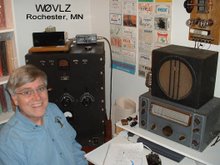 Well, it's in the log...the first QSO. Tonight I worked Lou, VE3AWA, on 3565. We were 549-559 both ways and had a nice contact going until 80 meter QRM caught up with us. Lou was using his Push-Pull TPTG transmitter with a NC101X. I had my HRO Sr paired with the Hartley running 10 watts input and about 3 watts out.
Well, it's in the log...the first QSO. Tonight I worked Lou, VE3AWA, on 3565. We were 549-559 both ways and had a nice contact going until 80 meter QRM caught up with us. Lou was using his Push-Pull TPTG transmitter with a NC101X. I had my HRO Sr paired with the Hartley running 10 watts input and about 3 watts out.For this contact I added an extension to the main tuning capacitor shaft. Both my TNT and this Hartley are really sensitive to hand capacity. Adding 8" to the tuning shaft helped a lot as I moved onto frequency. I also used a VT-25, the military version of the type 10.
Not obvious in the Hartley list of parts are the National Velvet Vernier dials used by Ross Hull. These make a big difference adding mechanical bandspread to help overcome the 80 meter CW band being crammed into a few degrees of capacitor rotation at one end of its travel.
Lou asked how come my signal was so stable. Antennas swinging in the wind typically shift the transmitter frequency as the load changes. My 105' inverted "L" happens to be a little low (only 10-20' off the ground) and behind a ridge so it is protected from the west winds. I also run with the antenna loosely coupled to the transmitter. Output is only about three watts instead of the 5-6 watts the transmitter is capable of at maximum coupling.
The RF choke is now one I hand wound on a 3/4" piece of wooden rod like Ross Hull's original 1928 design. It doesn't have quite as many turns as he called for but it works fine.






